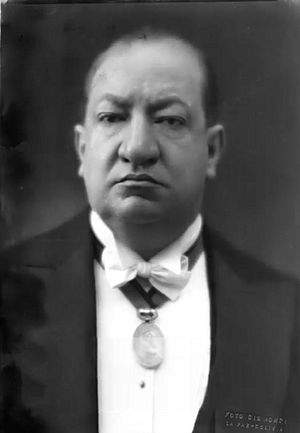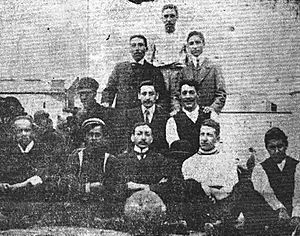José Luis Tejada Sorzano facts for kids
Quick facts for kids
José Luis Tejada Sorzano
|
|
|---|---|

Official photograph by Luigi Domenico Gismondi, c. 1934
|
|
| 34th President of Bolivia | |
| In office 1 December 1934 – 17 May 1936 Acting: 28 November 1934 – 1 December 1934 |
|
| Vice President | Vacant |
| Preceded by | Daniel Salamanca |
| Succeeded by | Germán Busch (provisional) |
| 23rd Vice President of Bolivia | |
| In office 5 March 1931 – 1 December 1934 |
|
| President | Daniel Salamanca |
| Preceded by | Abdón Saavedra |
| Succeeded by | Enrique Baldivieso |
| 1st President of the Bolivian Olympic Committee | |
| In office 17 June 1932 – 17 May 1936 |
|
| Vice President | Alfredo H. Otero |
| Preceded by | Office established |
| Succeeded by | Federico Nielsen-Reyes |
| Minister of Finance | |
| In office 21 March 1919 – 4 October 1919 |
|
| President | José Gutiérrez Guerra |
| Preceded by | Darío Gutiérrez |
| Succeeded by | Demetrio Toro |
| Personal details | |
| Born |
José Luis Tejada Sorzano
12 January 1882 La Paz, Bolivia |
| Died | 4 October 1938 (aged 56) Arica, Chile |
| Political party | Liberal |
| Spouses | Elvira Flores Artieda Lucila Flores Alayza |
| Parents | Napoleón Tejada Guzman Josefa Ruiz de Sorzano Mendoza |
| Education | Higher University of San Andrés |
| Signature | |
José Luis Tejada Sorzano (born January 12, 1882 – died October 4, 1938) was a Bolivian lawyer, economist, and politician. He served as the 34th president of Bolivia from 1934 to 1936. He was the last president from the Liberal Party. Before becoming president, he was the 23rd vice president of Bolivia from 1931 to 1934.
Contents
Early Life and Education
José Luis Tejada Sorzano was born on January 12, 1882, in La Paz, Bolivia. His parents were Napoleón Tejada Guzman and Josefa Ruiz de Sorzano Mendoza. He went to the San Calixto Jesuit School for his early education.
He later studied law at the Higher University of San Andrés, graduating in 1904. While at university, he joined a literary group called Palabras Libres (Free Words). This group wrote stories, essays, poems, and political articles for the newspaper El Diario.
Football Career
Tejada Sorzano was a keen athlete. In 1901, he helped start the Bolivian Rangers Club, a soccer team in La Paz. He played on the team, which included fifteen local players. On December 20, 1903, his team, the Rangers, won a game against La Paz FBC.
A few years later, he and some former teammates helped create the Thunder Football Club. In September 1905, the Thunders played in the first interdepartmental soccer match in Bolivian history. This game was against Oruro Royal and celebrated the opening of a new railway.
Political Journey
Even though his student group faced challenges from the government, Tejada Sorzano was always a member of the Liberal Party. He worked to update liberal ideas and spoke out against the unfair actions of powerful mining companies.
As a lawyer, he became active in politics at a young age. In 1914, he was elected as a deputy to the National Congress. On March 21, 1919, President José Gutiérrez Guerra made him the Minister of Finance. He held this position until October of that year.
Becoming Vice President
In 1931, new elections were called in Bolivia. The Liberal Party and the Genuine Republican Party, who were against the current government, decided to work together. They chose Daniel Salamanca as their presidential candidate and José Luis Tejada Sorzano as his running mate. They won the election without anyone running against them and took office on March 5, 1931.
Vice President of Bolivia (1931–1934)
As Vice President, Tejada Sorzano was appointed the first president of the Bolivian Olympic Committee in June 1932. However, the start of the Chaco War put a hold on the committee's activities.
He was a quiet vice president and usually let President Salamanca handle most matters. Things changed when President Salamanca was removed from office by the Bolivian military on November 27, 1934. This happened because of disagreements about how the Chaco War was being fought. The army decided not to take power themselves right away. Instead, Tejada Sorzano became president after Salamanca was forced to resign. The military likely agreed to this because they believed Tejada Sorzano would be easier to work with than Salamanca. This turned out to be true.
President of Bolivia (1934–1936)
When Tejada Sorzano became president, the Liberal Party returned to power after 14 years. He quickly worked with Congress to extend his term by one year. This was to help see the country through the end of the Chaco War, which had been very difficult for Bolivia.
Even with some small successes towards the end of the war, Paraguay still controlled much of the disputed area when a ceasefire was agreed upon in June 1935. Eventually, a peace treaty gave most of the Chaco region to Paraguay, making Bolivia's territory smaller.
Despite his good intentions, many military leaders did not like Tejada Sorzano. They felt that politicians had caused the war and then failed to provide enough support to win it. The military spread the idea that politicians, not soldiers, were to blame for the war's outcome. This made the public angry, and much of that anger was directed at Tejada Sorzano.
At the same time, Bolivia faced severe economic problems that the long war had made worse. There was also a big issue with a U.S.-based oil company, Standard Oil Corporation. The company had refused to help Bolivia during the war and was accused of illegal activities. Because he couldn't solve these problems, Tejada Sorzano gave younger military officers a reason to take over the government.
On May 22, 1936, Major Germán Busch led a military takeover that removed Tejada Sorzano from office. Colonel David Toro then became the new president.
Later Life and Death
After being removed from office, Tejada Sorzano was forced to leave Bolivia. He died in Arica, Chile, just two years later, on October 4, 1938.
See also
 In Spanish: José Luis Tejada Sorzano para niños
In Spanish: José Luis Tejada Sorzano para niños
- Cabinet of José Luis Tejada Sorzano



